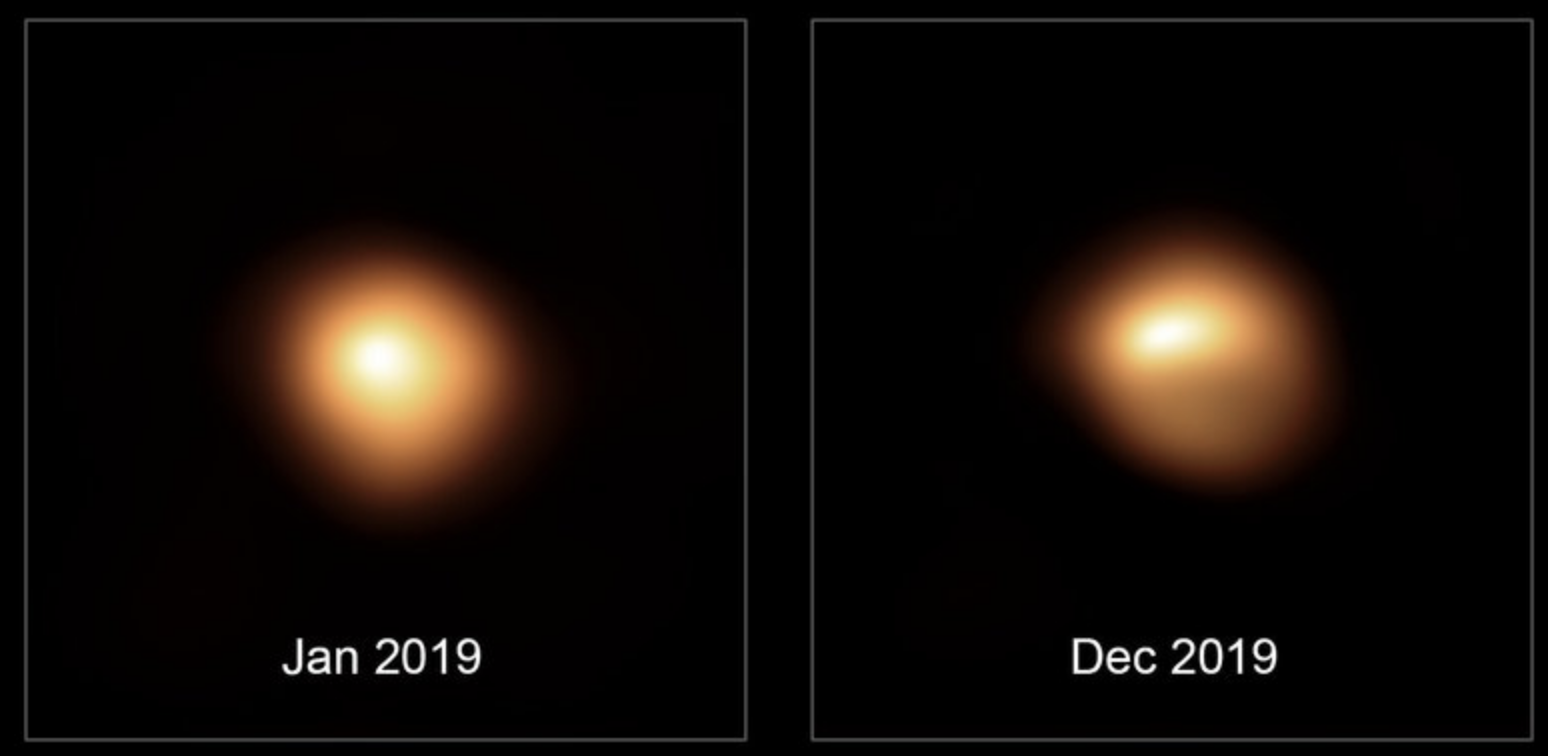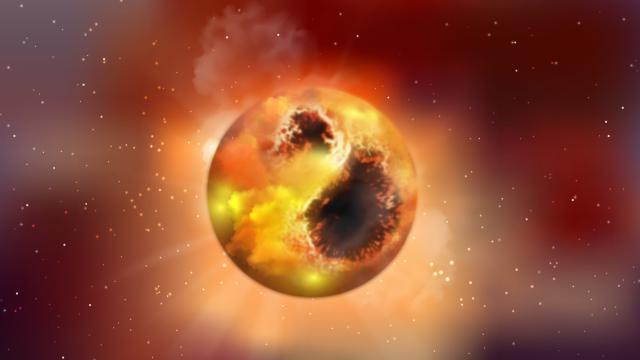Betelgeuse — a gigantic star in the final stages of its life — has been acting weird lately, exhibiting dramatic drops in brightness. New research attributes enormous star spots to Betelgeuse’s flaky appearance, though on a scale never seen before.
New research set for publication in The Astrophysical Journal Letters (preprint available here) connects dramatic luminosity drops on Betelgeuse to gigantic blemishes within its photosphere, the portion of a star’s surface that shines brightly. These dim, cool spots on Betelgeuse are reminiscent of sunspots, but they cover as much as 50% to 70% of the dying star’s surface. The new research was led by astronomer Thavisha Dharmawardena from the Max Planck Institute for Astronomy.
Betelgeuse is a red supergiant star located about 650 light-years from Earth. Set in the Orion constellation, it’s easily visible to the naked eye. A mind-boggingly big star, Betelgeuse has the mass of 11 Suns and a diameter equal to about 1,700 Suns lined up in a row). If you placed Betelgeuse at the centre of our solar system, it would extend all the way out to Jupiter’s orbit. Wow.
Betelgeuse is at the end of its life and could explode in a supernova basically at any time. It’s classified as a semi-regular variable star because its luminosity fluctuates over time, which is not unusual for red giants.
“Towards the end of their lives, stars become red giants,” said Dharmawardena in a press release. “As their fuel supply runs out, the processes change by which the stars release energy. As a result, they bloat, become unstable and pulsate with periods of hundreds or even thousands of days, which we see as a fluctuation in brightness.”
What is unusual, however, is the degree to which these dips in luminosity are seen in Betelgeuse. Recently, from October 2019 to April 2020, scientists observed as much as a 40% drop in the star’s normal brightness.
Red supergiants, owing to their immense surface area and relatively low density, easily jettison their outer gaseous layers into space, which, after cooling down, turn to dust. This process led Australian National University astronomer Daniel Cotton and his colleagues to conclude that copious amounts of dust in the vicinity of Betelgeuse can account for these strange drops in luminosity, as they explained in a recent paper.
Dharmawardena’s paper challenges this theory by using old and new data gathered by the Atacama Pathfinder Experiment (APEX) and the James Clerk Maxwell telescope (JCMT), which measure radiation at sub-millimetre wavelengths.
“What surprised us was that Betelgeuse turned 20% darker even in the sub-millimetre wave range,” explained Steve Mairs, a co-author of the study and a researcher at the East Asian Observatory.
Based on previous observations, the researchers concluded that this behaviour is not consistent with the presence of dust. Subsequent calculations within this spectral range affirmed these suspicions — that drops in luminosity within this sub-millimetre wave range cannot be accounted for by the presence of dust. Instead, something must be going on within the star itself, according to the new research.
Using a back-to-basics approach, the astronomers recognised that the brightness of a star depends on its diameter and surface temperature. Thus, the observed darkening in visible light and within the sub-millimetre wavelengths should cause a reduction in Betelgeuse’s mean surface temperature.

“However, an asymmetric temperature distribution is more likely,” explained study co-author Peter Scicluna from the European Southern Observatory (ESO). “Corresponding high-resolution images of Betelgeuse from December 2019 show areas of varying brightness.”
Taken together, this data points to the presence of huge star spots covering upwards of 50% to 70% of the visible surface area on Betelgeuse, at lower temperatures than the highly luminous photosphere.
Emily Levesque, an astronomy professor at the University of Washington and the author of the upcoming popular science book The Last Stargazers, was happy to see data on Betelgeuse in the sub-millimetre.
“Their observations show that Betelgeuse has been variable at these long wavelengths for a while, so understanding how this connects to the visibly dramatic dimming we saw last winter is definitely an important piece of the puzzle,” Levesque, who wasn’t involved in the new research, told Gizmodo.
“This result is extremely interesting, as it provides evidence that contradicts the previous assumptions stating that the historical dimming of Betelgeuse could be caused by dust. We seem to be facing conflicting observations between Dharmawardena and Cotton,” wrote Miguel Montargès from Ku Leuven’s Institute of Astronomy in an email to Gizmodo. “This is very exciting: It seems that the more we have data on Betelgeuse, the more complex it appears.”
Montargès, who’s not affiliated with the new research, did identify a problem, however, saying we’ve been looking at Betelgeuse from different wavelengths, with different angular resolutions, and with reference observations taken at different dates.
“Understanding this dimming — which seemed like a simple event — might give us food for thought for a while,” explained Montargès. “There is much we do not know about red supergiant stars and supernova progenitors.”
Levesque said it’s important to remember that Betelgeuse is just one red supergiant, and we’ve been fortunate to study it in detail owing to its brightness and close proximity.
“We don’t know much yet about how most red supergiants vary with time in the sub-millimetre, or even how common these sudden drops in visible light are,” she said. “We’ll want to keep an eye on Betelgeuse in as many wavelengths as possible, and study more stars like it, in order to fully explain the physics of these massive dying stars.”
Indeed, the presence of star spots on Betelgeuse still needs to be confirmed by complementary lines of evidence, but if true, they would represent an entirely new class of stellar phenomenon. Future research should investigate the duration of these star spots, determine potential causes of them, and identify possible cycles. Our Sun, for example, expresses sunspots in 11-year cycles. The new study presents an intriguing result, but one requiring more compelling data.
